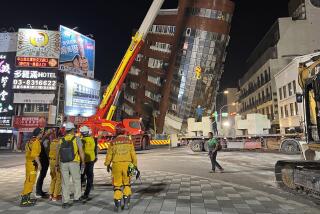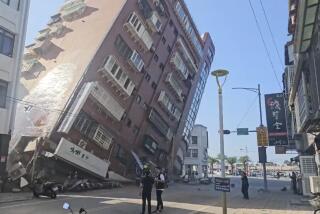Powerful aftershocks rattle Peru
Powerful aftershocks shook Peru today after a magnitude 8.0 earthquake throttled the nation the night before, killing at least 450 people and injuring more than 1,500, the United Nations said.
Roads were cut to the hard-hit southern region, officials said, hampering rescue efforts.
The death toll continued to rise as rescue workers dug beneath the rubble in the cities of Chincha and Pisco, near the epicenter off the Peruvian coast, 100 miles south of Lima, the capital.
The quake’s magnitude was raised from 7.9 to 8.0 today by the U.S. Geological Survey. At least 15 aftershocks followed, some as strong as magnitude 6.3.
In New York, U.N. Assistant Secretary-General Margareta Wahlstrom said Peruvian authorities told her agency that the death toll had risen to 450.
Hospitals were struggling to keep up with the flow of injured, local media reported.
Many buildings were damaged in Pisco and Chincha, and residents were reported to be stunned and looking for help.
About 200 people were waiting to be treated at a quake-damaged hospital in Chincha.
“Our services are saturated and half of the hospital has collapsed,” said Dr. Huber Malma, who was trying desperately to treat dozens of patients.
Large areas of Chincha were leveled. Dozens of homes, most of them built with adobe bricks, had collapsed.
In Pisco, about 125 miles south of the capital, the mayor told reporters that 200 or more people were buried in the rubble of a church, which collapsed when services were being held.
“The dead are scattered by the dozens on the streets,” Mayor Juan Mendoza told Lima radio station CPN.
Peruvian media reported that several people were killed when the bell tower of an 18th century church toppled in Ica, about 150 miles south of Lima. Dozens more were injured when hospital buildings collapsed and power lines fell in Ica, leaving the city of 200,000 in darkness as emergency workers searched for victims.
The U.S. Geological Survey said the quake, which struck at 6:41 p.m. local time Wednesday, occurred on a historically active thrust fault about 25 miles below the Earth’s surface. Two aftershocks measuring 5.9 and 5.8 on the Richter scale struck less than 30 minutes later.
Officials said the quake generated a 10-inch wave that quickly dissipated along the coast. Tsunami alerts were canceled in South and Central America, but an advisory remained in effect for Hawaii late Wednesday.
Peruvian authorities ordered the evacuation of several seaside communities, including one near Callao, the country’s largest port, where at least 70 buildings were damaged and dozens of people injured as structures collapsed, according to Gen. David Salazar, commander of the national police. Colombia’s southernmost port, Tumaco, also was ordered evacuated.
In Pisco, residents fled to higher ground even as authorities issued reports that the region was not in danger of being hit by tidal waves.
“We ask for calm,” President Alan Garcia said in a nationally televised address as he declared a state of emergency in Ica and the surrounding region. With repeated aftershocks striking the region, he said, Peruvians should leave coastal areas “as a precaution ... without panic.”
Lima media broadcast calls from coastal residents worried about tidal waves. Fishermen called in to Radio Programas del Peru saying the ocean looked “strange.”
A landslide blocked the coastal highway linking Lima to Pisco and other cities south of the capital. And the temblor sent thousands of people scurrying from high-rises in Lima, where two people were reported dead.
“We were on the fourth floor, and it caught us totally by surprise,” said Patricia Miyashiro, a Lima office worker. “All the books fell, and we ran out to the street.”
Some buildings were damaged in central Lima, and there were reports of fires at a clothing warehouse.
USGS officials said the quake took place “at the boundary between the Nazca and South American tectonic plates.” The South American plate is creeping west, up and over the Nazca plate, at the rate of 3 inches per year, according to USGS.
Ica, a provincial capital, appeared to take the hardest hit. Officials said the city’s cathedral, whose El Señor de Luren chapel is the focal point of an annual pilgrimage in October, was severely damaged.
At least one of the church’s towers collapsed. According to news reports, some people had gathered at the church for the celebration of the Assumption of the Virgin Mary, a Roman Catholic day of obligation celebrated Aug. 15.
Witnesses said that in the hours after the quake the city was a picture of desolation and destruction, with downed power poles blocking streets and looters roaming the business district.
“The hospitals have collapsed, the doctors are treating patients outside the four hospitals,” reporter Gustavo Sulca of America TV told Peruvian viewers from Ica. “People are roaming about the medical centers seeking help.”
The Lima newspaper El Comercio reported on its website that Ica residents had gathered in parks and other open areas as aftershocks continued late Wednesday.
President Garcia said he was sending the country’s health minister and two other Cabinet members to Ica.
Garcia ordered off-duty police to report to Lima to prevent looting and ordered public schools closed today until inspectors could guarantee their buildings’ safety.
hector.tobar@latimes.com
Special correspondent León reported from Lima and staff writer Tobar from Mexico City. Times staff writer Patrick J. McDonnell in Sao Paulo, Brazil, and Andrés D’Alessandro of The Times’ Buenos Aires Bureau contributed to this report. The Associated Press also contributed.More to Read
Sign up for The Wild
We’ll help you find the best places to hike, bike and run, as well as the perfect silent spots for meditation and yoga.
You may occasionally receive promotional content from the Los Angeles Times.






















